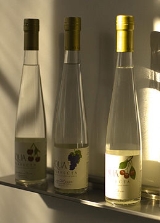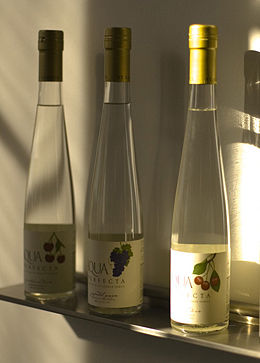
Eau de vie
Encyclopedia

Production
A typical scenario would involve growing the appropriate fruit, harvesting it when ripe, fermenting the crushed fruit, and then distilling. Eaux-de-vie are typically not aged in wooden casks, hence they are clear. The ripe fruit is fermented, distilled, and quickly bottled in order to preserve the freshness and aroma of the parent fruit. Although this is the usual practice, some variants do exist, and some distillers age their products before bottling.Some commonly available flavors are eau-de-vie de poire (pear), eau-de-vie de pomme (apple), eau-de-vie de mirabelle (yellow plum), and eau-de-vie de pêche (peach). When made from pomace
Pomace
Pomace , or marc , is the solid remains of grapes, olives, or other fruit after pressing for juice or oil. It contains the skins, pulp, seeds, and stems of the fruit....
, it is called pomace brandy
Pomace brandy
Pomace brandy is a liquor distilled from pomace. Examples include the Croatian / Montenegrin / Serbian lozovača , Cypriot zivania, French marc, Georgian chacha, German Tresterbrand, Greek tsipouro, Hungarian törköly, Italian grappa, Bulgarian grozdova, Portuguese aguardente, Romanian rachiu de...
or marc.
The French apple-flavored spirit calvados
Calvados (spirit)
Calvados is an apple brandy from the French région of Basse-Normandie or Lower Normandy.-History:Apple orchards and brewers are mentioned as far back as the 8th century by Charlemagne. The first known Norman distillation was carried out by "Lord" de Gouberville in 1554, and the guild for cider...
is made by aging it in wooden casks before bottling.
The term can also refer to maple eau-de-vie
Maple liqueur
Maple liqueur refers to various alcoholic products made from maple syrup, primarily in the Northeast United States and Canada.In Canadian French, such products are known as eau de vie d'érable....
, made from maple syrup
Maple syrup
Maple syrup is a syrup usually made from the xylem sap of sugar maple, red maple, or black maple trees, although it can also be made from other maple species such as the bigleaf maple. In cold climates, these trees store starch in their trunks and roots before the winter; the starch is then...
.
Although eau de vie is a French term, similar distilled beverage
Distilled beverage
A distilled beverage, liquor, or spirit is an alcoholic beverage containing ethanol that is produced by distilling ethanol produced by means of fermenting grain, fruit, or vegetables...
s are produced in other countries (e.g., German Schnaps, Balkan rakia
Rakia
Rakia is an alcoholic beverage that is produced by distillation of fermented fruit; it is a popular beverage throughout the Balkans. Its alcohol content is normally 40% ABV, but home-produced rakia can be stronger . Prepečenica is double-distilled rakia which has an alcohol content that may...
, Romania
Romania
Romania is a country located at the crossroads of Central and Southeastern Europe, on the Lower Danube, within and outside the Carpathian arch, bordering on the Black Sea...
n tuica
Tuica
Ţuică is a traditional Romanian spirit of somewhere in between 45%-60% alcohol by volume. It is usually made from plums.Ţuică is the official name for the drink when it is prepared only from plums...
, Czech
Czech Republic
The Czech Republic is a landlocked country in Central Europe. The country is bordered by Poland to the northeast, Slovakia to the east, Austria to the south, and Germany to the west and northwest....
slivovice
Slivovitz
Slivovitz or Slivovitsais a distilled beverage made from Damson plums. It is frequently called plum brandy, and in the Balkans is part of the category of drinks called rakia...
, Slovak
Slovakia
The Slovak Republic is a landlocked state in Central Europe. It has a population of over five million and an area of about . Slovakia is bordered by the Czech Republic and Austria to the west, Poland to the north, Ukraine to the east and Hungary to the south...
slivovica
Slivovitz
Slivovitz or Slivovitsais a distilled beverage made from Damson plums. It is frequently called plum brandy, and in the Balkans is part of the category of drinks called rakia...
, Hungarian
Hungary
Hungary , officially the Republic of Hungary , is a landlocked country in Central Europe. It is situated in the Carpathian Basin and is bordered by Slovakia to the north, Ukraine and Romania to the east, Serbia and Croatia to the south, Slovenia to the southwest and Austria to the west. The...
palinka
Palinka
Pálinka or Palincă is a traditional fruit brandy made in regions of the Carpathian Basin. Modern commercial production occurs in Hungary, Romania and parts of Austria. It is commonly made from the fermentation of plums, but other fruits used include apricots, apples, pears, peaches and cherries...
, Sri Lanka
Sri Lanka
Sri Lanka, officially the Democratic Socialist Republic of Sri Lanka is a country off the southern coast of the Indian subcontinent. Known until 1972 as Ceylon , Sri Lanka is an island surrounded by the Indian Ocean, the Gulf of Mannar and the Palk Strait, and lies in the vicinity of India and the...
n coconut arrack, and Georgian
Georgia (country)
Georgia is a sovereign state in the Caucasus region of Eurasia. Located at the crossroads of Western Asia and Eastern Europe, it is bounded to the west by the Black Sea, to the north by Russia, to the southwest by Turkey, to the south by Armenia, and to the southeast by Azerbaijan. The capital of...
chacha (ჭაჭა)
Chacha (liquor)
Chacha is traditionally a clear strong liquor, which is sometimes called "vine vodka," "grape vodka," or "Georgian vodka." Chacha is made of grape pomace...
.
Serving
Exact serving preferences vary by individual, but here are some general guidelines:- Serving size: Usually served as a digestif (a postprandialPostprandialPostprandial means after eating a meal while preprandial is before a meal.-Usages of the term:This term is used in many contexts but also in relation to blood sugar levels, which are normally measured 2 hours after and before eating in a postprandial glucose test...
alcoholic drink that aids digestion). The typical serving size is 1–2 ounces, owing to the high alcohol content of the spirit and to the fact that it is typically drunk after a meal during which wine, or some other alcoholic beverage, has already been served. - Glassware. Some connoisseurs recommend a tulip-shaped glass; others recommend a snifterSnifterA snifter — also called a balloon — is a type of stemware, a short-stemmed glass whose vessel has a wide bottom and a relatively narrow top. It is mostly used to serve aged brown spirits such as brandy and whisky...
.
Etymology
Eau de vie is a French expression that means water of life. Other spiritsDistilled beverage
A distilled beverage, liquor, or spirit is an alcoholic beverage containing ethanol that is produced by distilling ethanol produced by means of fermenting grain, fruit, or vegetables...
have similar etymologies, such as whisky
Whisky
Whisky or whiskey is a type of distilled alcoholic beverage made from fermented grain mash. Different grains are used for different varieties, including barley, malted barley, rye, malted rye, wheat, and corn...
, which is an anglicization of the Irish
Irish language
Irish , also known as Irish Gaelic, is a Goidelic language of the Indo-European language family, originating in Ireland and historically spoken by the Irish people. Irish is now spoken as a first language by a minority of Irish people, as well as being a second language of a larger proportion of...
uisce beatha or of the Scottish Gaelic
Scottish Gaelic language
Scottish Gaelic is a Celtic language native to Scotland. A member of the Goidelic branch of the Celtic languages, Scottish Gaelic, like Modern Irish and Manx, developed out of Middle Irish, and thus descends ultimately from Primitive Irish....
uisge beatha. Similarly, we see aqua vitae
Aqua vitae
Aqua vitae, or aqua vita, is an archaic name for a concentrated aqueous solution of ethanol. The term was in wide use during the Middle Ages, although its origin is undoubtedly much earlier having been used by Saint Patrick and his fellow monks to refer to both the alcohol and the waters of baptism...
in Latin (ˈɑːkwə ˈvaɪtiː) and akvavit
Akvavit
Akvavit or aquavit is a traditional flavoured spirit that is principally produced in Scandinavia, where it has been produced since the 15th century....
(ækvəˈviːt) in the Scandinavian languages. The Slavic terms wódka (Polish
Polish language
Polish is a language of the Lechitic subgroup of West Slavic languages, used throughout Poland and by Polish minorities in other countries...
) and vodka (Russian
Russian language
Russian is a Slavic language used primarily in Russia, Belarus, Uzbekistan, Kazakhstan, Tajikistan and Kyrgyzstan. It is an unofficial but widely spoken language in Ukraine, Moldova, Latvia, Turkmenistan and Estonia and, to a lesser extent, the other countries that were once constituent republics...
) are diminutives of the words for water.
See also
- AkvavitAkvavitAkvavit or aquavit is a traditional flavoured spirit that is principally produced in Scandinavia, where it has been produced since the 15th century....
- Aqua vitaeAqua vitaeAqua vitae, or aqua vita, is an archaic name for a concentrated aqueous solution of ethanol. The term was in wide use during the Middle Ages, although its origin is undoubtedly much earlier having been used by Saint Patrick and his fellow monks to refer to both the alcohol and the waters of baptism...
- ArmagnacArmagnac (drink)Armagnac is a distinctive kind of brandy or eau de vie produced in the Armagnac region in Gascony, southwest France. It is distilled from wine usually made from a blend of Armagnac grapes, including Baco 22A, Colombard, and Ugni Blanc, using column stills rather than the pot stills used in the...
- BrandyBrandyBrandy is a spirit produced by distilling wine. Brandy generally contains 35%–60% alcohol by volume and is typically taken as an after-dinner drink...
- Fruit brandy
- CognacCognac (drink)Cognac , named after the town of Cognac in France, is a variety of brandy. It is produced in the wine-growing region surrounding the town from which it takes its name, in the French Departements of Charente and Charente-Maritime....
- DamassineDamassineDamassine is a liqueur produced by distillation of the Damassine prune from the Damassinier tree..According to local tradition, the Crusaders or Bernard de Clairvaux brought seeds for the Damassinier plant back from the Orient . The Romans might have already known the fruit, cited in the Duhamel...
- GrappaGrappaGrappa is an alcoholic beverage, a fragrant, grape-based pomace brandy of Italian origin that contains 35%–60% alcohol by volume...
- PalinkaPalinkaPálinka or Palincă is a traditional fruit brandy made in regions of the Carpathian Basin. Modern commercial production occurs in Hungary, Romania and parts of Austria. It is commonly made from the fermentation of plums, but other fruits used include apricots, apples, pears, peaches and cherries...
- RakiaRakiaRakia is an alcoholic beverage that is produced by distillation of fermented fruit; it is a popular beverage throughout the Balkans. Its alcohol content is normally 40% ABV, but home-produced rakia can be stronger . Prepečenica is double-distilled rakia which has an alcohol content that may...
- SchnappsSchnappsSchnapps is a type of distilled alcoholic beverage. The English word schnapps is derived from the German Schnaps , which can refer to any strong alcoholic drink but particularly those containing at least 32% ABV...
- SlivovitzSlivovitzSlivovitz or Slivovitsais a distilled beverage made from Damson plums. It is frequently called plum brandy, and in the Balkans is part of the category of drinks called rakia...
- WilliamineWilliamineWilliamine is a brand of Poire Williams, an eau de vie produced with Williams pears, in Martigny, Canton of Valais, Switzerland.The trademark Williamine belongs to the ....
External links
http://dafina.net/forums/read.php?54,104173

